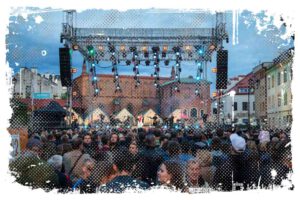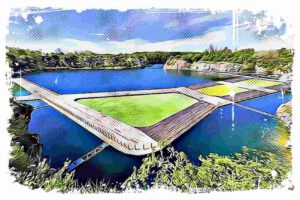You might be asking yourself, „What’s a barbican?” in Kraków? Picture a sturdy building designed to guard the most vulnerable part of a city wall – the entrance gate. That’s what a barbican is. It’s a kind of architectural fingerprint left by medieval times, typically circular in design. One such historical treasure is the Barbican in Krakow. I can tell you, it’s one of the finest examples you’ll find in Poland.

The Story Behind Krakow’s Barbican
If you want to understand the roots of Krakow’s Barbican, we need to rewind to the reign of King Olbracht. Now, there’s a saying, „Under King Olbracht, the nobility died out”, which might be a bit of an overstatement. However, it does mark a pivotal moment. Specifically, it began after a disastrous battle against the Turks and Wallachians in 1497, known as the Bukovina defeat.

This defeat stirred fear in King Jan I Olbracht of a possible Wallachian-Turkish invasion on his city, Krakow, and his royal seat. King Jan, being a proactive man, personally oversaw the construction of the Barbican. I think it’s noteworthy to mention that he supposedly laid the cornerstone himself. No penny was spared and the construction advanced rapidly. So, by 1499, the Barbican stood tall and proud at Krakow’s gates where it still stands today.
The Imposing Architecture of Krakow’s Barbican

So what does the Barbican in Krakow look like? Like its siblings, Krakow’s Barbican flaunts a circular design. Its primary role was to shield the Florian Gate, which served as the starting point to the road leading to the Wawel Royal Castle – the king’s residence. The Barbican’s robust walls, reaching up to 3 meters, were built using limestone and bricks. The limestone was ideal for withstanding the moisture from the surrounding moat while the bricks formed the fire-resistant upper part of the wall. It’s crowned with seven observation towers. Access was only possible via two drawbridges.
↳ Make sure to read my guide to the most amazing places to stay in Kraków:
How to Find Best Place to Stay in Krakow Old Town – Your Guide
The Barbican boasted a total of 130 arrow slits – openings from which firearms were shot. For defense, boiling oil or hot tar were frequently poured through machicolations, which are overhanging structures with floor openings. Such weaponry was formidable against invaders. The Barbican was considered a strong fortress until the Swedish Deluge, when the crew had to surrender, not because they ran out of ammunition, but because of food shortage.
An Unforgettable Shot at the Barbican

The Barbican’s history includes a noteworthy event involving Marcin Oracewicz. Oracewicz was known for his remarkable marksmanship and creative thinking. During the Bar Confederation in 1768, when he ran out of bullets, he resorted to using a button from his Żupan to take down the Russian commander. This daring act took place right in Krakow’s Barbican.
The Survival of Krakow’s Barbican
You might be wondering, how did the Barbican in Krakow survive when most of the city walls were taken down in the 19th century? That’s where Senator and architect Feliks Radwański comes in. He advocated for the preservation of the Barbican, arguing that it shielded the residents from harsh winds from the north and west. His argument stated that exposure to these winds might lead to ailments like rheumatism, frequent fluxes, and perhaps even paralysis. I know it’s a unique argument but it worked! Thanks to Radwański, the Barbican was saved and transformed into a monument and a tourist attraction.
Krakow’s Barbican Today
Today, the Barbican in Krakow serves cultural purposes and is managed by the Historical Museum of the City of Krakow. If you need a dose of history, art or entertainment, the Barbican is the place to go. It hosts exhibitions, historical reconstructions and even an open-air cinema! So, being there, you need to know, you’re stepping into a historical landmark that brims with cultural events.
10 Things You Didn’t Know About the Barbican

If you’re fascinated by historical buildings or you’re just plain curious, I’ve got something for you. I’m about to reveal ten interesting facts about the Barbican in Krakow. Each one of these snippets tells a tale, peeling back the layers of time that this remarkable monument has lived through.
- Standing tall since the 15th century, the Barbican in Krakow is among the few surviving barbicans in Poland. It was strategically positioned in front of the Florian Gate to safeguard the city entrance.
- Structurally, the Barbican in Krakow is designed as a circular segment. Its internal diameter exceeds 24 meters slightly and its walls are up to 3 meters thick.
- The Barbican is a testament to Gthic architecture, crowned with seven turrets. In medieval times, it was connected to the Florian Gate by a long neck and armed with shooting holes for its defense.
- The Barbican in Krakow was built between 1498 and 1499 under the reign of King Jan Olbracht. It was a response to potential Wallachian-Turkish invasions, a threat that became real after the defeat of Bukovina, or the renowned Battle of Koźmin.
- When King Jan Olbracht chose to construct the Barbican in Krakow, he was inspired by the barbicans in Toruń. Their remarkable defensive capabilities had left a lasting impression on the king.
- In fact, Jan Olbracht was so involved in the project that he personally laid the cornerstone for the Barbican in Krakow and funded the project with a hundred fines.
- Fast forward to the 19th century, when there were plans to demolish the Barbican and St Florian’s Gate. However, Senator Feliks Radwański, an architect and professor at the Jagiellonian University, was against this idea. He argued that their absence would let strong northern winds into the city, causing rheumatism and other health problems among the inhabitants.
- In 1910, during the 500th anniversary of the victory at Grunwald, there were plans to display the Grunwald Panorama by Jan and Tadeusz Styk at the Barbican. However, this never happened due to concerns about potential damage to the historic building.
- A plaque honoring Marcin Oracewicz can be found on the Barbican. Legend has it that during the Bar Confederation, when Oracewicz ran out of ammunition defending Krakow, he loaded his rifle with a Chamara button and killed the Russian commander.
- Concerns over possible damage to the Barbican led to the “Battle of Grunwald” by Tadeusz Popiel and Zygmunt Rozwadowski painting being displayed in a specially constructed building at St. spirit, instead of the Barbican itself.
I believe, whether you’re a history enthusiast or simply someone who appreciattes architecture, these facts would make you appreciate the Barbican in Krakow even more. And, if you want to delve deeper, there’s no better place to visit than the Barbican itself!

Conclusion – Is it Worth Visiting?
The Barbican in Krakow is worth visiting for several reasons:
- Historical Significance – The Barbican was once a fortified outpost that served as a gateway leading to the old town of Krakow. It is one of the best-preserved examples of gothic architecture and is among the only three remaining fortified outposts in Europe.
- Cultural Attraction – The Barbican is home to the Museum of Urban Engineering, which is rich with history. It offers a fascinating insight into the development and engineering of the city.
- Beautiful Architecture – The Barbican is a stunning example of gothic architecture, with its redbrick bulwarks and intricate design. It provides a picturesque backdrop for photos and offers a unique glimpse into the city’s medieval past.
- Museum Experience – Inside the Barbican, visitors can explore the museum and learn about the fortification system and the history of Krakow. It is a great opportunity to immerse oneself in the city’s rich cultural heritage.
- Location – The Barbican is located in Old Town, the old town of Krakow. It is surrounded by other attractions such as the Wawel Royal Castle and the Old town, making it a convenient stop while exploring the city.
Overall, the Barbican in Krakow offers a combination of historical significance, architectural beauty, and cultural exploration, making it a worthwhile destination for visitors to the city.
References
- https://www.expedia.com/Krakow-Barbican-Krakow-Old-Town.d6066489.Vacation-Attraction
- https://theculturetrip.com/europe/poland/articles/20-must-visit-attractions-in-krakow/
- https://tourscanner.com/blog/things-to-do-in-krakow/



